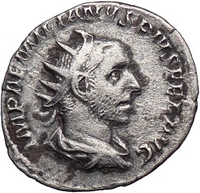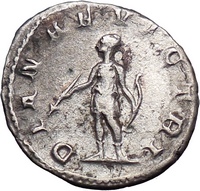Aemilian Rare Roman Emperor 253AD Biography Authentic Ancient Roman
Coins


Example of Authentic Ancient
Coin of:
Aemilian - Roman Emperor: July
or August - October 253 A.D.
Silver Antoninianus Rome mint: 253
A.D.
Reference: RIC IV 2b, RSC IV 10
Pedigree: Ex Stacks Bowers & Ponterio
IMP AEMILIANVS PIVS FEL AVG, radiate, draped and cuirassed bust right,
from behind. DIANAE VICTRI, Diana standing half left, bow in left hand,
arrow in right.
Marcus Aemilius Aemilianus (Girba,
c. 207/213
Spoletium, 253), commonly known as
Aemilian, was
Roman Emperor for three months in 253.
Commander of the
Moesian troops, he obtained an
important victory against the invading
Goths
and was, for this reason, acclaimed emperor by his army. He then moved
quickly to Italy, where he defeated emperor
Trebonianus Gallus, only to be killed
by his own men when another general,
Valerian, proclaimed himself emperor
and moved against Aemilian with a larger army.
Biography
Origins
and military career
Aemilian was born in the
Roman province of
Africa. According to the 4th century
source
Epitome de Caesaribus, he was born
at Girba (modern
Djerba, an island off the coast of
Tunisia) and was a
Moor; a reference in the same source
hints that he was born around 207. The 12th century historian
Joannes Zonaras, who calls him a Libyan
(that is, coming from western Egypt-eastern Libya) rather than a Moor,
and another chronicle of the 13th century hold that he was forty at the
time of his death in 253. As regards his lineage, there are two
versions, both exaggerated: while
Eutropius and his translator
Paeanius probably defamate a failed usurper when they tell
that he was from an insignificant family,
John of Antioch may refer bits of
Aemilian's propaganda when he tells that the usurper used his ancestry
to take the power. Aemilian married
Cornelia Supera, a woman of African
origin; the year of their marriage is unknown, but being both from the
same place, it is possible they married before Aemilian left Africa.
During the reign of
Trebonianus Gallus and his son
Volusianus (251253), Aemilian was sent to the
Balkans to command an army. His primary responsibility was to
assure peace along the
Danube frontier, which had been subject
to several attacks by the
Goths led by king
Cniva.
Gallus secured the throne after the death of emperor
Decius at the hands of Cniva in the
battle of Abrittus (251), and later had
to manage an outbreak of
plague that devastated Rome. He was not
popular with the army, mainly due to humiliating treaties signed in 251
with the Goths and King
Shapur I of Persia who attacked
Syria. According to John of Antioch,
upon his appointment to the Moesian command, Aemilian was already
envious of Gallus and plotted treachery against him. He was also an
opponent of the
Roman Senate; and his seditious plans
are confirmed by
Jerome and
Jordanes.
Victory
against the Goths, overthrow of Gallus, short rule and death of Aemilian
In 253 the
Goths, led by king
Cniva,
protested not having received the tribute due by the Romans according to
the treaty of 251 and crossed the border, attacking
Cappadocia,
Pessinus, and
Ephesus; the opinion of modern historians is that this
missing payment was not a change in Roman policy, and the Goths were
more likely trying to capitalize on their military prowess. Aemilian had
command of the army assigned to defend the area. However, the recent
defeat at the
battle of Abrittus put his troops on
edge. Aemilian exhorted them, reminding them of Roman honour (according
to Zosimus) and promising tribute from the Goths (according to Zonaras).
The Romans took the Goths by surprise, killing most of them, followed by
an invasion of their territory which resulted in booty and the
liberation of prisoners. The Roman soldiers, gathered by Aemilian,
acclaimed him Emperor. Jordanes claims, however, that Aemilian's troops
plundered Roman territory, rather than keep the tribute of the Goths.
With his few men, Aemilian could hardly wait for the legitimate
emperor Gallus to gather his forces, so he left his province unguarded
and, with all his men, moved quickly towards
Rome,
to meet his opponent before he could receive reinforcements. While
Aemilian descended upon Rome along the
Flaminian Way,
Trebonianus Gallus and his son and
colleague
Volusianus had him proclaimed "enemy of
the State" by the
Roman senate, then exited Rome to meet
the usurper; this strategy is a clue that Aemilian's army was smaller
than theirs, as it is probable that they did not expect the
reinforcements to come in time, but trusted their larger army to win the
clash. The two armies met at
Interamna Nahars (modern
Terni),
at the southern end of the eastern branch of the Flaminia, and Aemilian
won the battle; Gallus and Volusianus fled with few followers towards
north, probably to gather time before the arrival of the reinforcements,
but at Forum Flaminii (modern
San Giovanni Profiamma), on the western
branch of Flaminia, they were killed by some of their own guards, who
thought that their betrayal could earn them a reward.
Aemilian moved towards Rome; here the
Roman senate, after a short opposition,
decided to recognize him emperor. According to some sources, after his
recognition Aemilian wrote to the Senate, promising to fight for the
Empire in Thrace and against Persia, and to relinquish his power to the
Senate, of which he considered himself a general. Aemilian received the
titles of Pius, Felix and Pater Patriae, the
tribunicia potestas, and was elevated to the rank of
pontifex maximus; however, he was
not elevated to consulate (possibly a hint of his non-senatorial birth).
His coinage shows that his propaganda was centred around his capability
as military commander; he had been able to defeat the Goths while nobody
even believed this possible, and thus he was the right man for the job
of restoring the power of the
Roman Empire.
However,
Valerian, the governor of the Rhine
provinces, was on his way south with an army, which according to
Zosimus, had been called in as a reinforcement by Gallus. But
modern historians believe this army, possibly mobilized for an incumbent
campaign in the East, moved only after Gallus' death to support its
general's bid for power. Emperor Aemilian's men, fearful of a civil war
and Valerian's larger force, mutinied. Aemilian was killed by them at
Spoletium or the Sanguinarium
bridge, between
Oriculum and
Narnia (half way between Spoletium
and Rome), and recognised Valerian as the new emperor. After his death,
which happened between late July and mid-September, a
damnatio memoriae against Aemilian
was declared.
It is possible that the usurper
Silbannacus was an officer left by
Aemilian in Rome before moving against Valerian, who later tried to
become emperor but then was killed.
The troubled administration of this emperor was perhaps best summed
up by
Eutropius:
|
|
Aemilianus came from an extremely insignificant family, his
reign was even more insignificant, and he was slain in the third
month. |
|